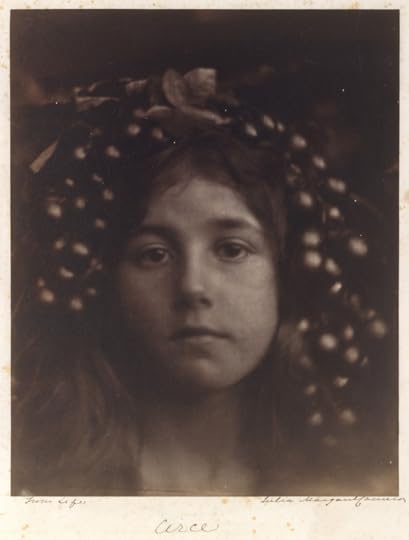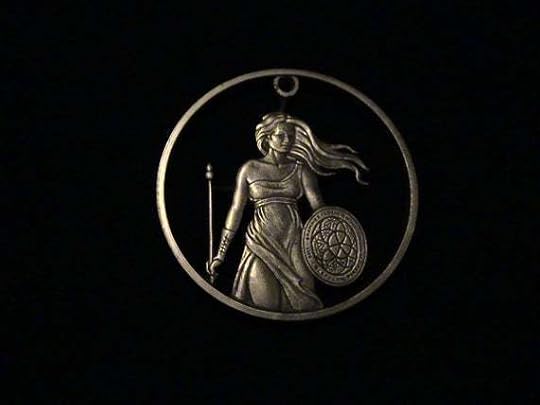Vicky Alvear Shecter's Blog, page 2
November 26, 2023
Re-Issue of Song of War Out Now!
i
The release of this novel snuck right past us during Thanksgiving Week, but A Song of War: A Novel of Troy is finally out! Like our other collaborative novel, A Day of Fire: A Novel of Pompeii, we joined with authors who love ancient history and wrote the novel together, each of us taking a specific character from the Homeric epic and weaving them in and out of each other’s stories. I wrote about Odysseus and thoroughly enjoyed living in his wily imagination, fueled by his thorny competitiveness with his frenemy, the golden boy, Diomedes. The man of a thousands faces never ceases to entertain.
Here’s more on the book:
A Song of War: A Novel of Troy
Troy: city of gold, gatekeeper of the east, haven of the god-born and the lucky, a city destined to last a thousand years. But the Fates have other plans—the Fates, and a woman named Helen. In the shadow of Troy’s gates, all must be reborn in the greatest war of the ancient world: slaves and queens, heroes and cowards, seers and kings . . . and these are their stories.
A young princess and an embittered prince join forces to prevent a fatal elopement.
A tormented seeress challenges the gods themselves to save her city from the impending disaster.
A tragedy-haunted king battles private demons and envious rivals as the siege grinds on.
A doomed hero launches a desperate plan to bring the war to a close.
A grizzled archer and a desperate Amazon risk their lives to avenge their dead.
A trickster conceives the greatest trick of all.
A goddess’ son battles to save the spirit of Troy even as the walls are breached in fire and blood.
Seven authors bring to life the epic tale of the Trojan War: its heroes, its villains, its survivors, its dead. Who will lie forgotten in the embers, and who will rise to shape the bloody dawn of a new age?
Purchase from:
The post Re-Issue of Song of War Out Now! appeared first on Vicky Alvear Shecter.
August 23, 2023
The Re-Release of Our Award-Winning Pompeii Novel
Several years ago, six historical fiction authors played with a fun idea. What if we all wrote a novel together? What if we each picked a character whose story line threaded through everyone else’s story? And what if we weaved them all together to tell one powerful story?

That’s how A Day of Fire: A Novel of Pompeii was born. And Harper-Collins just re-released it with an awesome new cover. The other two in the series—A Year of Ravens: A Novel of Boudicca, and A Song of War: A Novel of Troy—will be coming out soon.
The publisher describes it this way:
From six bestselling authors, including New York Times bestseller Kate Quinn, comes a vividly imagined novel following the lives of those in ancient Pompeii on the fateful day Mount Vesuvius erupts.
Pompeii was a lively resort flourishing in the shadow of Mount Vesuvius at the height of the Roman Empire. When Vesuvius erupted in an explosion of flame and ash, the entire town would be destroyed. Some of its citizens died in the chaos, some escaped the mountain’s wrath . . . and these are their stories:
A boy loses his innocence in Pompeii’s flourishing streets.An heiress dreads her wedding day, not knowing it will be swallowed by fire.An ex-legionary stakes his entire future on a gladiator bout destined never to be finished.A crippled senator welcomes death, until a tomboy on horseback comes to his rescue.A young mother faces an impossible choice for her unborn child as the ash falls.A priestess and a prostitute seek redemption and resurrection as the town is buried.Six authors bring to life overlapping stories of patricians and slaves, warriors and politicians, villains and heroes who cross each other’s paths during Pompeii’s fiery end. But who will escape, and who will be buried for eternity?
You can read a sample or order directly from the publisher here. You can also order from the links below, or order it from you local bookstore.

So what do you think of the new covers?
The post The Re-Release of Our Award-Winning Pompeii Novel appeared first on Vicky Alvear Shecter.
April 11, 2023
Nefertiti, Ancient Eyeliner, and My Amphora Earrings
I marched my way into the Michael C. Carlos Museum at Emory University yesterday. I was pumped up to tour high school Latin students through our Greek and Roman galleries, only to learn that the tour was cancelled. And I’d even put on my new earrings from Plato’s Fire for the occasion!
My lil phone photo does not capture the shiny awesomeness of these amphorae. And no, they are not heavy. If you love all things ancient Greek, check them out (nope, not sponsored, just a fan). Personally, I’m lusting for the octopus earrings next.
Anyway, since I was already at the museum, I decided to spend a little more time with the Life and Afterlife: Ancient Egyptian Art from the Senusret Collection exhibit, which runs through August 6th. If you haven’t seen it yet, I highly recommend it. And if you would like a tour, contact me, and we’ll set something up.
 The earrings!
The earrings!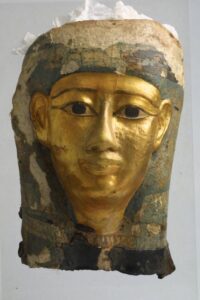 Gilded mummy mask. 26th Dynasty.
Gilded mummy mask. 26th Dynasty.Nefertiti’s Sarcophagus
There are many breathtaking pieces to check out, including this beautiful gilded funerary mask on the right from the 26th Dynasty, the last native-ruled dynasty in Egypt. After this dynasty, it was one invasion after another–by the Persians, then Alexander the Great and the Greeks, and finally the Romans with emperor Augustus.
But nearly one thousand years before this mask was even imagined, Queen Nefertiti ruled alongside her husband, the heretic king, Akhenaten, in the 18th Dynasty. And this beautiful piece of red granite (below) has been identified as a remnant of a sarcophagus of the long-necked, powerful queen.
How cool is that? There is a great little video beside this fragment explaining how it was identified.
Dr. Melinda Hartwig, curator of the collection and of the Egyptian, Nubian and Near Eastern galleries of the Museum, does a great job explaining what makes it unique, namely the fact that this is the first example of a god’s name (Aten) shown encapsulated in a cartouche. Normally, this was reserved for pharaohs. One can only wonder at what Akhenaten and Nefertiti were up to with that bit of power-theater. Dr. Hartwig also tells us that this piece is being returned to Egypt after this exhibition, so this may be your last chance to stand before something the queen herself may have commissioned.
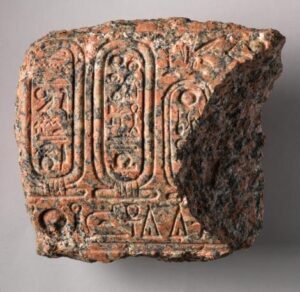 Armana Royal Sarcophagus Fragment. 1353-BCE-1336BCE
Armana Royal Sarcophagus Fragment. 1353-BCE-1336BCEHold My Eyeliner
I always love those moments when you see something and can completely relate to it on a personal level.
I got this sense when I stood before the case, holding what looked to me like a bleached-out tube of mascara. Sure enough, it is an eyeliner applicator. Deep inside the well of that small holder of black kohl are likely the dried out remnants of the lead-based paint the ancient Egyptians used to adorn their eyes. The duck or goose fat they would have used to make it spreadable is likely long gone. There’s a very good chance this object was owned by a man, as both men and women wore makeup in ancient Egypt.
Pharaohs, royal wives, priests, scribes, and nobles alike would never be caught dead in public without their eyes decorated with khol.
 Wepwawet Amulet 1076-332 BCE
Wepwawet Amulet 1076-332 BCEWolf City
Finally, I fell in love with a small amulet of a wolf. Associated with the god Wepwawet, this deity was called the “Opener of the Ways.” He is often depicted as a wolf standing on a prow of a solar boat, presumably growling at any real or imagined enemies of Ra. Some scholars believe his body language suggests that he is acting as a scout to help pave the way for Egyptian warriors.
His cult center was in the city of Asyut in Upper Egypt, which the Greeks later dubbed Lycopolis, or “Wolf City.”
Elegantly beautiful, isn’t it?
Don’t miss this wonderful exhibit! Remember, you can visit for free by checking out the family pass from your local public library.
The post Nefertiti, Ancient Eyeliner, and My Amphora Earrings appeared first on Vicky Alvear Shecter.
April 5, 2023
“Don’t Make Up What You Don’t Know!”
Seems a bit obvious, doesn’t it? After all, Don’t make up what you don’t know is standard in academia. But that hasn’t always been the case when it comes to conserving ancient artifacts, says Dr. Renée A. Stein, Director of Conservation and Chief Conservator at the Carlos Museum at Emory University.
At yesterday’s “AntiquiTEA” presentation at the museum, she pointed out that many preservation techniques used in decades/centuries past often included a bit of…well, individual artistic “interpretation” to repairs. To make them look “nice” or presentable for viewing.
When Something Goes MissingDr. Stein made this comment in response to a question about one artifact, in particular, a bust with a missing nose. Would the team ever consider reconstructing the nose if they had a similar piece with the same face with an intact nose?
Nope, Dr. Stein said. Because they could never be sure, that was the “exact” nose they should duplicate.
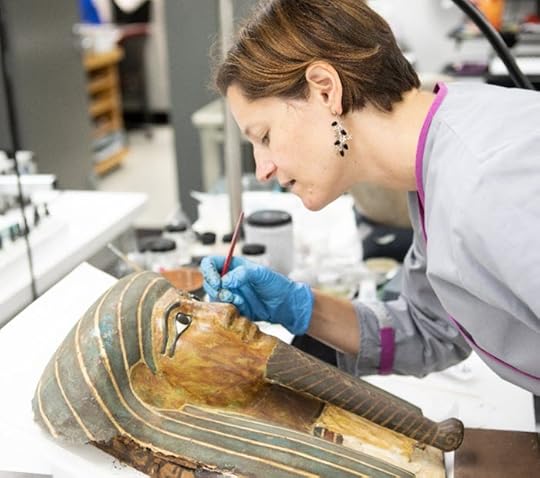
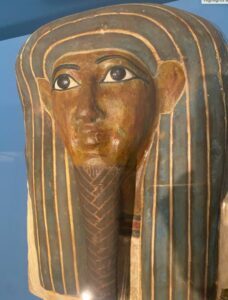 Ancient Egyptian Coffin Lid Head. 722-655 BCE, 25th Dynasty, when rulers from Nubia (today's Sudan) went north and conquered and ruled Egypt.
Ancient Egyptian Coffin Lid Head. 722-655 BCE, 25th Dynasty, when rulers from Nubia (today's Sudan) went north and conquered and ruled Egypt.Egyptian Afterlife
It’s always fascinating to get a look at the depth of consideration that comes into the art and science of conserving ancient artifacts. Dr. Stein led a roundtable with fellow conservators who worked on ancient Egyptian objects for Life and the Afterlife: Ancient EgyptianArt from the Senusret Collection, a special exhibit at the Carlos that will run through August 6, 2023.
The conservators used x-rays, UV, and infrared lights to study the chemical make up of the objects/paints and also performed “micro excavations” on each piece exhibited in the collection. If you haven’t seen it yet, get thee to the Carlos Museum right away. It’s a fascinating and fantastic look at how deeply ancient Egyptians loved life–and how much they wanted it to continue in the afterlife. If you are in Atlanta, send me a message, and we’ll set up a time when I can tour you through the exhibit.
 Ancient Egypt Mummy Mask, 197-30 BCE. This piece is from the Ptolemaic era, or when Egypt was ruled by the Greek descendants of Alexander the Great's general, Ptolemy. Cleopatra VII was the last pharaoh of this era (and no that is NOT her...).
Ancient Egypt Mummy Mask, 197-30 BCE. This piece is from the Ptolemaic era, or when Egypt was ruled by the Greek descendants of Alexander the Great's general, Ptolemy. Cleopatra VII was the last pharaoh of this era (and no that is NOT her...).The post “Don’t Make Up What You Don’t Know!” appeared first on Vicky Alvear Shecter.
March 3, 2023
Nefertiti, Ancient Eyeliner, and My Amphora Earrings
 The earrings!
The earrings!I marched my way into the Michael C. Carlos Museum at Emory University yesterday all pumped up to tour high school Latin students through our Greek and Roman galleries only to learn…the tour was cancelled. And I’d even put on my new earrings from Plato’s Fire for the occasion!
My lil’ iphone photo does not capture the shiny awesomeness of these amphorae. And no, they are not heavy. If you love all things ancient Greek, check them out (nope, not sponsored, just a fan). Personally, I’m lusting for the octopus earrings next.
Anyway, since I was already at the museum, I decided to spend a little more time with the Life and Afterlife: Ancient Egyptian Art from the Senusret Collection exhibit, which runs through August 6th. If you haven’t seen it yet, I highly recommend it. And if you would like a tour, contact me and we’ll set something up.
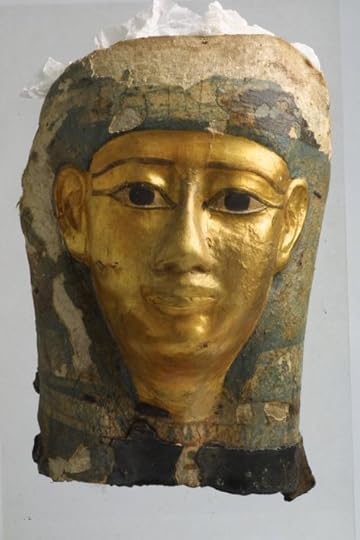 Gilded mummy mask. 26th Dynasty.
Gilded mummy mask. 26th Dynasty.Nefertiti’s Sarcophagus
There are many breathtaking pieces to check out, including this beautiful gilded funerary mask on the right from the 26th Dynasty, the last native-ruled dynasty in Egypt. After this dynasty, it was one invasion after another–by the Persians, then Alexander the Great and the Greeks, and finally the Romans with emperor Augustus.
But nearly one thousand years before this mask was even imagined, Queen Nefertiti ruled alongside her husband, the heretic king, Akhenaten, in the 18th Dynasty. And this beautiful piece of red granite (below) has been identified as a remnant of a sarcophagus of the long-necked, powerful queen.
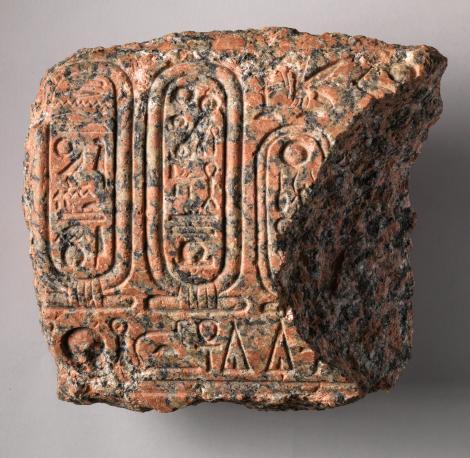 Armana Royal Sarcophagus Fragment. 1353-BCE-1336BCE
Armana Royal Sarcophagus Fragment. 1353-BCE-1336BCEHow cool is that? There is a great little video beside this fragment explaining how it was identified.
Dr. Melinda Hartwig, curator of the collection and of the Egyptian, Nubian and Near Eastern galleries of the Museum, does a great job explaining what makes it unique, namely the fact that this is the first example of a god’s name (Aten) shown encapsulated in a cartouche. Normally, this was reserved for pharaohs. One can only wonder at what Akhenaten and Nefertiti were up to with that bit of power-theater. Dr. Hartwig also tells us that this piece is being returned to Egypt after this exhibition, so this may be your last chance to stand before something the queen herself may have commissioned.
Hold My Eyeliner
I always love those moments when you see something and can completely relate to it on a personal level.
I got this sense when I stood before the case holding what looked to me like a bleached-out tube of mascara. Sure enough, it is an eyeliner applicator. Deep inside the well of that small holder of black kohl are likely the dried out remnants of the lead-based paint the ancient Egyptians used to adorn their eyes. The duck or goose fat that they would have used to make it spreadable is likely long gone. There’s a very good chance this object was owned by a man as both men and women wore makeup in ancient Egypt.
Pharaohs, royal wives, priests, scribes, and nobles alike would never be caught dead in public without their eyes decorated with khol.
Wolf City
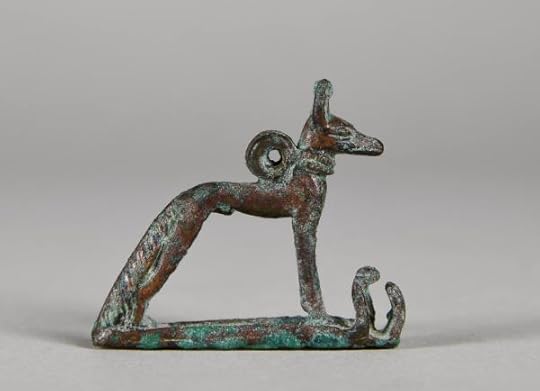 Wepwawet Amulet 1076-332 BCE
Wepwawet Amulet 1076-332 BCEFinally, I fell in love with a small amulet of a wolf. Associated with the god Wepwawet, this deity was called the “Opener of the Ways.” He is often depicted as a wolf standing on a prow of a solar boat, presumably growling at any real or imagined enemies of Ra. Some scholars believe his body language suggests that he is acting as a scout to help pave the way for Egyptian warriors.
His cult center was in the city of Asyut in Upper Egypt, which the Greeks later dubbed Lycopolis, or “Wolf City.”
Elegantly beautiful, isn’t it?
Don’t miss this wonderful exhibit! Remember you can visit for free by checking out the family pass from your local public library.
The post Nefertiti, Ancient Eyeliner, and My Amphora Earrings appeared first on Vicky Alvear Shecter.
February 22, 2023
“Don’t Make Up What You Don’t Know!”
 Ancient Egyptian Coffin Lid Head. 722-655 BCE, 25th Dynasty when rulers from Nubia (today’s Sudan) went north and conquered and ruled Egypt.
Ancient Egyptian Coffin Lid Head. 722-655 BCE, 25th Dynasty when rulers from Nubia (today’s Sudan) went north and conquered and ruled Egypt.Seems a bit obvious doesn’t it? After all, Don’t make up what you don’t know is standard in academia. But that hasn’t always been the case when it comes to conserving ancient artifacts, says Dr. Renée A. Stein, Director of Conservation and Chief Conservator at the Carlos Museum at Emory University.
At yesterday’s “AntiquiTEA” presentation at the museum, she pointed out that many preservation techniques used in decades/centuries past often included a bit of…well, individual artistic “interpretation” to repairs. To make them look “nice” or presentable for viewing.
When Something Goes MissingDr. Stein made this comment in response to a question about one artifact in particular, a bust with a missing nose. Would the team ever consider reconstructing the nose if they had a similar piece of with the same face with an intact nose?
Nope, Dr. Stein said. Because they could never be sure that was the “exact” nose they should duplicate.
Egyptian AfterlifeIt’s always fascinating to get a look at the depth of consideration that comes into the art and science of conserving ancient artifacts. Dr. Stein led a roundtable with fellow conservators who worked on ancient Egyptian objects for Life and the Afterlife: Ancient EgyptianArt from the Senusret Collection, a special exhibit at the Carlos that will run through August 6, 2023.
 Ancient Egypt Mummy Mask, 197-30 BCE. This piece is from the Ptolemaic era, or when Egypt was ruled by the Greek descendants of Alexander the Great’s general, Ptolemy. Cleopatra VII was the last pharaoh of this era (and no that is NOT her…).
Ancient Egypt Mummy Mask, 197-30 BCE. This piece is from the Ptolemaic era, or when Egypt was ruled by the Greek descendants of Alexander the Great’s general, Ptolemy. Cleopatra VII was the last pharaoh of this era (and no that is NOT her…).The conservators used x-rays, UV and infrared lights to study the chemical make up of the objects/paints and also performed “micro excavations” on each piece exhibited in the collection. If you haven’t seen it yet, get thee to the Carlos Museum right away. It’s a fascinating and fantastic look at how deeply ancient Egyptians loved life–and how much they wanted it to continue in the afterlife. If you are in Atlanta, send me a message and we’ll set up a time where I can tour you through the exhibit.
The post “Don’t Make Up What You Don’t Know!” appeared first on Vicky Alvear Shecter.
November 12, 2020
Elvis Never Left the Building!
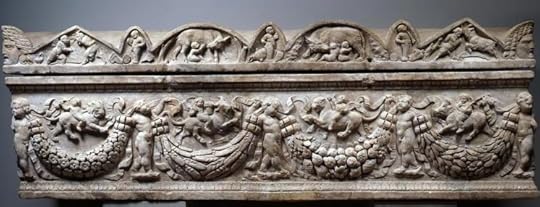 Courtesy of the Michael C. Carlos Museum
Courtesy of the Michael C. Carlos MuseumHe’s right there on the corner of ancient Roman sarcophagus above. Don’t see him? Let’s zoom in: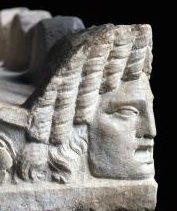
That’s him on the left. It’s supposed to be Medusa who is there to ward off evil, but that never looked like Medusa to me. On my gallery tours for the Michael C. Carlos Museum, I often describe her as “Screaming Elvis.” Amazingly, Elvis shows up a lot in ancient art. 
On the right is another Screaming Elvis, I mean, Medusa, on a different Roman sarcophagus. A sarcophagus is essentially a carved stone coffin. In the second century, Romans had a special knack for showing off their wealth and status, even in death. If you were poor, your body was likely burned and your ashes gathered into a small ceramic jar and shoved into a niche with the rest of your poor family.
But if you were wealthy–well! Time to dazzle the plebes, eh? Which was why these stone coffins where displayed above ground. There’s a good chance they were also painted and maybe even gilded.
But what if all this bragging about wealth and status attracted the wrong kind of attention? How could you keep evil away from your everlasting resting place?
Their solution? Plonk a headless Medusa on each corner of the coffin.
Except, Medusa is supposed to be terrifyingly ugly, with snakes for hair. On e look at her and you became your own sarcophagus before you can blink. So why carve Medusa as Elvis? It’s one of the enduring mysteries of the ancient world (lol). Most likely, the carvers wanted her depiction to remain consistent with the rest of the art.
e look at her and you became your own sarcophagus before you can blink. So why carve Medusa as Elvis? It’s one of the enduring mysteries of the ancient world (lol). Most likely, the carvers wanted her depiction to remain consistent with the rest of the art.
In early Greece, this is how Medusa was depicted:
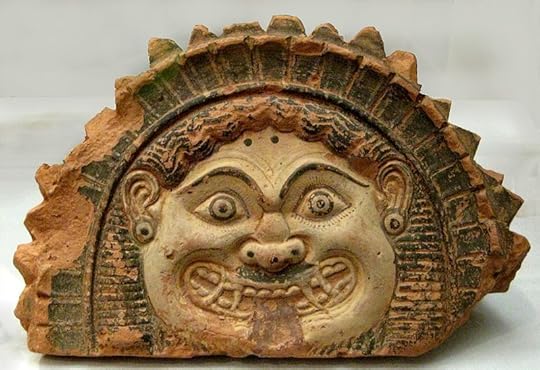 Look at them fangs!
Look at them fangs!But by Roman times, Medusa was much tamer–a look-alike Elvis with a pompadour.
You could argue that the ancient world’s preoccupation with facial symmetry means that they just accidentally ended up looking the early rock star.
Or maybe a pretty face is just a pretty face.
 An Elvis look-alive was dug up in ancient Iran as well in what was then called Commagene. Rumor had it he had a pretty singing voice.
An Elvis look-alive was dug up in ancient Iran as well in what was then called Commagene. Rumor had it he had a pretty singing voice.The post Elvis Never Left the Building! appeared first on Vicky Alvear Shecter.
March 6, 2020
It’s Women’s History Month So Let’s Talk Kick-Butt Ancient Warrior Queens!
Powerful women are always fascinating, but there is something especially intriguing about women in the ancient world who led their kingdoms and also led armies into battle. Both were extraordinarily difficult in eras where women generally had very little economic and social power, let alone political and military strength. With Elizabeth Warren–arguably the most qualified candidate–dropping out of the race for the U.S. presidency we are left to wonder how these ancient women managed to pulled it off. How did they navigate the power structures that tried to stop them at every turn?
That’s what led me to write Warrior Queens: True Stories of Six Ancient Rebels Who Slayed History. Let’s start with the first queen in the collection: Hatshepsut, the female pharaoh depicted above by the brilliant illustrator Bill Mayer. Some historians may think that Hatshepsut doesn’t really belong on this list because there is some question as to whether she actually led her forces into battle. However, I relied on writings of the period–by men who claimed to have served under her in defeat of Egypt’s enemies–as proof. Plus, the mere fact that she ruled successfully for decades during an era of prosperity, expansion, and artistic breakthroughs certainly makes her worthy of study in her own right.
The most shocking thing about Hatshepsut’s story is how her successor tried to erase her from history. He almost succeeded too–carvings of her name were struck through, her statues destroyed, and all mention of her struck from the record. Why? You can read about many of the theories for this in my book but in essence, the most likely reason is that he simply didn’t want to be the guy who “followed” a woman.
Misogyny, man. It’s old and runs deep.
As docent at the Carlos Museum at Emory University, I’m constantly finding new objects that relate to the stories I write about it. Check out this head of a Nubian from Hatshepsut’s Dynasty:
Multiple sculpted heads lined the sides of the pharaoh’s balcony, where she made appearances. On one side where the heads of Nubians–like the one above–showing the enemies to the south she destroyed. On the right were the heads of Syrians–her neighbors to the east–that she also invaded. What a wonder it was to discover that this head in our museum dated to Hatshepsut’s era!
You can read more about Hatshepsut and other fascinating rulers in Warrior Queens! And don’t forget to share them with the young warrior queenlings in your life!
The post It’s Women’s History Month So Let’s Talk Kick-Butt Ancient Warrior Queens! appeared first on Vicky Alvear Shecter.
February 22, 2020
Wait, This is a CHILD, not Circe!
At first I was beguiled by the sweet intensity and realness of the girl in this image from The Met Collection . Then I saw the artist’s title for the photograph: CIRCE.
I immediately went into mama-lionness mode: This is a CHILD! Why would the photographer name her after the wily, sexual witch who turned men into pigs and kept Odysseus in her bed?!
 Remember this photo Carroll took of young Alice Liddell?
Remember this photo Carroll took of young Alice Liddell?Sexualizing children, it seems, has a long tradition. The photograph is dated to 1865. Imagine my surprise to find that the artist was a woman–Julia Margaret Cameron. I had assumed it had been taken by a Lewis Caroll-like character (see photo on right for the inspiration for Alice in Wonderland).
Discovering the artist was a woman does not mitigate the problematic nature of sexualizing young girls.
Now, the artist could have called the photograph, “Young Circe.” Then the child’s open, guileless innocence would make sense–this is the face of a girl who does not yet know that she will be called a witch or a “dreadful goddess” because she dares to live under no man’s rule. She does not yet know that her island of peace will be invaded by sailors who could do her serious harm.
She does not yet know that the only tool she has available for protection (her magic) will be disabled by a male god in favor of the man who invades her isle, Odysseus. She does not yet know that this same god–Hermes–will tell Odysseus that when she tries to protect herself with her staff, he must draw his “sharpened sword and rush at her as if you mean to kill her. She will be frightened with you and will tell you to sleep with her.” Book 10 from Emily Wilson’s translation of Homer’s Odyssey.
Yeah, because that’s what women do when they’re rushed at with a drawn weapon–“tell” their attackers to sleep with them.
Who has the power here? She may have been called a witch-goddess, but Odysseus was given the power and means to conquer her. More like, Circe agrees to sleep with him in order to, you know, not be killed.
But yeah, she “tells” Odysseus to sleep with her. But before he “deigns” to do so, he makes her take an oath–likely with the point of his sword still to her neck–to not to hurt him or his men. She agrees.
From the male-centric point of view, Odysseus “conquers” the wily, witchy sex goddess. From the female perspective, I dunno, it sounds a lot like rape ( a woman acquiescing to sexual demands in exchange for continuing to breathe). Libbie Hawker’s take on Circe’s story brilliantly conveys the nuances in Circe’s reality in A Sea of Sorrow: A Novel of Odysseus.
But even if we take the story at face value–that Circe commands Odysseus to take her to bed–at no time do we picture Circe as a young girl. She is clearly a grown woman. Despite being stripped of her power by Hermes and Odysseus, she is a strong “goddess-witch” in her own right. She does what she must to survive and protect her people and her isle. She even helps Odysseus resume his quest to go home.
So why would the artist call her portrait of a sweet, innocent girl, Circe? Apparently Cameron inscribed the photo with this partial quote from Milton: “Who knows not Circe/daughter of the sun.”
Still doesn’t answer the question though. All I know is that this child is not Circe. This is how I picture her:
Tamer of Wolves/Survivor/Bad Bitch/GrownWoman
 Model Joy Jones by Dark Wolf Photography: https://business.facebook.com/darkwolfphotography/?tn-str=k*F
Model Joy Jones by Dark Wolf Photography: https://business.facebook.com/darkwolfphotography/?tn-str=k*FKeep howling, Circe!
The post Wait, This is a CHILD, not Circe! appeared first on Vicky Alvear Shecter.
September 17, 2019
Odysseus Before and After
If you follow me on social media, then you know that I have a new pup named Ody (for Odysseus). He’s a lovable wild man. I just got him groomed and you can see the startling change in my intrepid adventurer:
Long live Odysseus!
If you want to keep up with Ody’s adventures, he has his own instagram. In the meantime, I’ll try not to let him get lost at sea (i.e., so bedraggled) next time!
The post Odysseus Before and After appeared first on Vicky Alvear Shecter.



